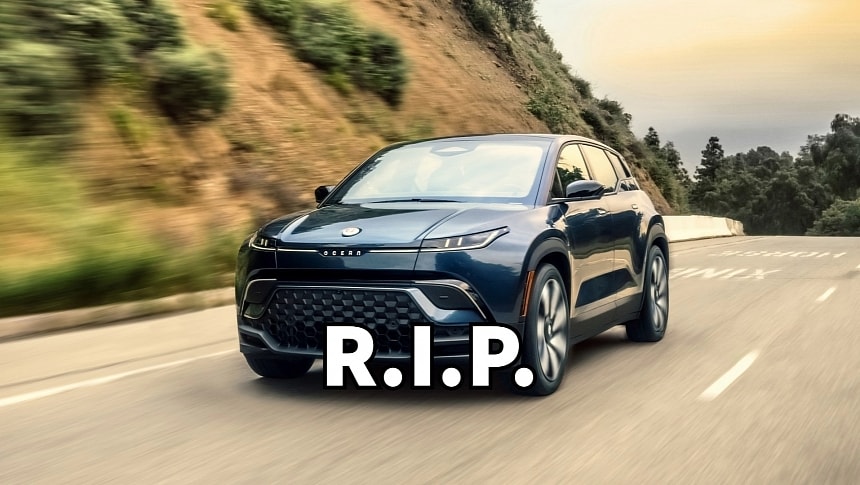Fisker has been dodging the inevitable for months after it burned through cash while its vehicles have proven a hard sell. The EV startup filed for bankruptcy protection in Delaware, a move that was anticipated a long time ago. Fisker is looking to sell its assets, estimated at between $500 million and $1 billion, to cover liabilities of $100 million to $500 million.
Henrik Fisker is a Danish automotive designer and entrepreneur best known for designing luxury cars. However, he will forever remain in public perception for running into the ground, not one, but two auto startups. Fisker believed in an "asset-light" business model, which allowed the company to take care of the design while a contract manufacturer did the rest. However, its first product, the Ocean SUV, once touted as a "Tesla Model Y killer," has committed suicide instead.
Fisker may blame its downfall on harsh economic conditions, an unforgiving capital market, and the slowing of EV adoption. However, the naked truth is that the Ocean SUV was really bad, as revealed by a huge number of complaints, investigations, and recalls. Fisker's failure didn't occur because the market was tough. The Fisker Ocean would've failed in any market because of its many problems that put buyers off. This made it impossible for Fisker to find buyers for more than half of the SUVs it produced in 2023.
With hardly any sales, Fisker started burning its cash reserves at an alarming rate, and no corrective action could help. The improved 2.0 software, which should've solved Fisker Ocean's teething problems, proved inept, forcing the EV startup to consider bankruptcy protection. This became clear after talks with a major carmaker, probably Nissan, fell apart. Fisker reportedly hired restructuring advisors in March to work on a potential bankruptcy filing.
Three months later, the work paid off, so to speak, as Fisker filed for Chapter 11 bankruptcy protection on June 17. The company is looking to sell its assets, which it evaluated to be $500 million to $1 billion, to cover liabilities of $100 million to $500 million. According to the filing, Fisker has about 200-999 creditors. The company said it's also "in advanced talks" with financial stakeholders for debtor-in-possession (DIP) financing without offering further details.
Debtor-in-possession financing would allow Fisker to use the proceeds from the asset selloff to finance operations during restructuring. This debt takes precedence over all other debt and is usually used to keep a business operating until it can be sold for a greater return. Sometimes, it can also be used to give a troubled company a new start, although I'm unsure Fisker has any chances left.
Fisker has significantly cut the Ocean prices in an attempt to clear inventory, selling them at $25,000, down from $63,000. Fisker employees were offered an even sweeter deal at $20,000. However, it's unclear who would take the risk even at these prices, considering that the company provides no service and spare parts, no warranty, and even roadside assistance has been canceled. Existing owners are equally affected, offering a brutal example for anyone considering buying a car from another startup.
Fisker may blame its downfall on harsh economic conditions, an unforgiving capital market, and the slowing of EV adoption. However, the naked truth is that the Ocean SUV was really bad, as revealed by a huge number of complaints, investigations, and recalls. Fisker's failure didn't occur because the market was tough. The Fisker Ocean would've failed in any market because of its many problems that put buyers off. This made it impossible for Fisker to find buyers for more than half of the SUVs it produced in 2023.
With hardly any sales, Fisker started burning its cash reserves at an alarming rate, and no corrective action could help. The improved 2.0 software, which should've solved Fisker Ocean's teething problems, proved inept, forcing the EV startup to consider bankruptcy protection. This became clear after talks with a major carmaker, probably Nissan, fell apart. Fisker reportedly hired restructuring advisors in March to work on a potential bankruptcy filing.
Three months later, the work paid off, so to speak, as Fisker filed for Chapter 11 bankruptcy protection on June 17. The company is looking to sell its assets, which it evaluated to be $500 million to $1 billion, to cover liabilities of $100 million to $500 million. According to the filing, Fisker has about 200-999 creditors. The company said it's also "in advanced talks" with financial stakeholders for debtor-in-possession (DIP) financing without offering further details.
Debtor-in-possession financing would allow Fisker to use the proceeds from the asset selloff to finance operations during restructuring. This debt takes precedence over all other debt and is usually used to keep a business operating until it can be sold for a greater return. Sometimes, it can also be used to give a troubled company a new start, although I'm unsure Fisker has any chances left.
Fisker has significantly cut the Ocean prices in an attempt to clear inventory, selling them at $25,000, down from $63,000. Fisker employees were offered an even sweeter deal at $20,000. However, it's unclear who would take the risk even at these prices, considering that the company provides no service and spare parts, no warranty, and even roadside assistance has been canceled. Existing owners are equally affected, offering a brutal example for anyone considering buying a car from another startup.







